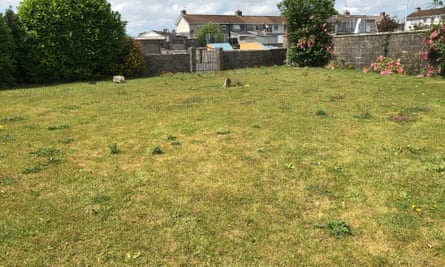
On a balmy summer day, the site of the children’s mass grave in Tuam appears deceptively bucolic.
There are no crosses or tombstones in the walled patch of grass.
Butterflies flit over shrubs.
Robins cheep from branches.
It’s peaceful.
“They are two-feet down from where we are standing,” Catherine Corless said. “The bones have mingled together and water got in and thrashed them around. But they’re there.”
Corless is the local historian who a decade ago alerted Ireland, and the world, to a shocking truth about this Galway town: for decades an institution for unmarried mothers put the remains of dead babies and children in a disused subterranean septic tank.
Corless found that, between 1925 and 1961, 796 children died at the St Mary’s mother and baby home, run by nuns from the Bon Secours order – but there were no burial records. Many are believed to have ended up in the former sewage facility.
“It became a handy way to dispose of them,” Corless told the Observer. “They didn’t have to account for the deaths. They didn’t want anyone to know. All this time those poor little remains were disintegrating.”
The bones, and their secrets, are to be excavated. A team of forensic investigators led by Daniel Mac Sweeney, a former International Committee of the Red Cross envoy, has been tasked with exhuming, analysing and identifying the remains.
“There has been nothing on this scale before in Ireland,” Roderic O’Gorman, the children’s minister, said in an interview. “This will be one of the most complex operations of its kind in the world.”
The age of the remains, the fact they are children and have been exposed to water will complicate analysis and identification. The excavation team will be independent but is legally obliged to use advanced techniques to match DNA samples with living relatives, said O’Gorman. “Anything that can be done will be done.”
The goal is to give a respectful burial to all the remains, he said. “I’ve always regarded Tuam as a stain on our national conscience. The fact that infant remains were treated so callously even in death is deeply disturbing.”
The home in Tuam was part of a network of institutions for unmarried mothers and their children that doubled as orphanages and adoption agencies for much of the 20th century.
They were run by religious orders with sanction by the state, which overlooked deprivation, misogyny, stigma and high infant mortality rates.
The government made a formal state apology in 2021 after a judicial commission report.
Tuam – whose name is derived from a Latin term for burial mound – evokes special shame.
Corless, 68, remembers encountering children from the home when she was a child.
They were considered embodiments of sin and looked down upon.
As a trick Corless, aged around seven, gave one of them a stone wrapped in a sweet paper.
The girl grabbed it, expecting a treat.
The memory haunts Corless.
“Those kids had absolutely nothing. I remember the actual hurt on her face.”
The home closed in 1961, was demolished and replaced with a housing estate.
In 1975 two boys foraging for apples stumbled across human bones in the abandoned septic tank.
Authorities took no action.
Some suggested they were remains from the 1840s famine.
Corless, a former textile factory secretary with an interest in local history, began investigating the site.
The Bon Secours order and local authorities fobbed her off but she amassed death certificates and information about the septic tank.
National and international media seized on her research in 2014, prompting an official investigation.
DNA samples taken in 2016 confirmed the remains dated from the Bon Secours occupancy of the site.
Hunger and neglect afflicted the children, said Corless. “The children were treated as commodities. The prettier babies were set up for adoption – it was a money-making racket. The sicker ones were put away and allowed to die.”
Corless, a mother of four adult children, resisted efforts to leave the remains in place and to memorialise the site with a plaque.
“Let them rest in peace? It was a sewage facility – get them out of there. Let’s expose the raw truth of what happened. You have to unearth the whole place to undo the damage. The people of Ireland need to know what happened.”
The Catholic church’s attempt to deny and minimise what happened left her cold.
“It turned me totally against the church. They turned their back on me and told lies.”
She hopes the excavation will shed light on how many were placed in the septic tank and the causes of death, and also lead to DNA matches with relatives and former residents of the home, paving the way for proper burials.
Mac Sweeney, who was appointed in May, recently met Corless at the site but has not disclosed when the excavation will begin.
Relatives hope it will be in the coming months.
Geoff Knupfer, a former Manchester detective who headed a commission to locate bodies of people “disappeared” during the Troubles, said the dig will probably involve archaeologists, anthropologists, investigators and site managers.
Not all remains will necessarily yield a positive DNA match, requiring careful management to avoid disputes about the ownership and fate of some remains, he warned.
“I fear this could prove something of a minefield. This process would be followed by coroners’ inquests and the release of remains to families – another potentially difficult area.”
Corless has received multiple awards and featured in documentaries.
The actor Liam Neeson visited her and is to make a dramatised film about her investigation.
In lieu of tombstones at the site locals have erected a number, 796.
PJ Haverty, a former resident of the home, also posted a note: “This is what Catholic Ireland did. Took the babies away from their mothers and when they passed away dumped their little bodies into a dirty tank. My God.”
